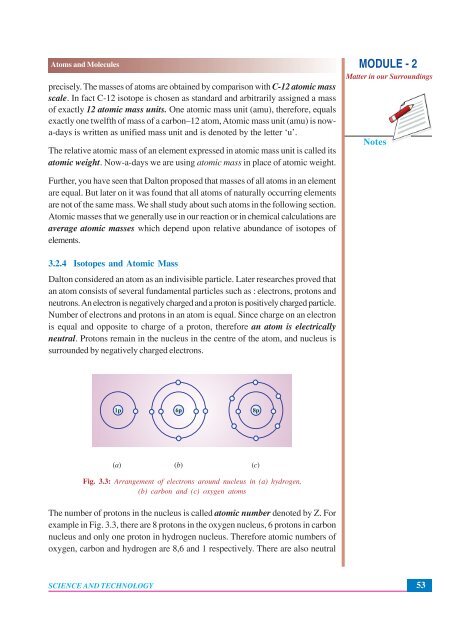Create successful ePaper yourself
Turn your PDF publications into a flip-book with our unique Google optimized e-Paper software.
Atoms and Molecules<br />
precisely. The masses of atoms are obtained by comparison with C-12 atomic mass<br />
scale. In fact C-12 isotope is chosen as standard and arbitrarily assigned a mass<br />
of exactly 12 atomic mass units. One atomic mass unit (amu), therefore, equals<br />
exactly one twelfth of mass of a carbon–12 atom, Atomic mass unit (amu) is nowa-days<br />
is written as unified mass unit and is denoted by the letter ‘u’.<br />
The relative atomic mass of an element expressed in atomic mass unit is called its<br />
atomic weight. Now-a-days we are using atomic mass in place of atomic weight.<br />
MODULE - 2<br />
Matter in our Surroundings<br />
Notes<br />
Further, you have seen that Dalton proposed that masses of all atoms in an element<br />
are equal. But later on it was found that all atoms of naturally occurring elements<br />
are not of the same mass. We shall study about such atoms in the following section.<br />
Atomic masses that we generally use in our reaction or in chemical calculations are<br />
average atomic masses which depend upon relative abundance of isotopes of<br />
elements.<br />
3.2.4 Isotopes and Atomic Mass<br />
Dalton considered an atom as an indivisible particle. Later researches proved that<br />
an atom consists of several fundamental particles such as : electrons, protons and<br />
neutrons. An electron is negatively charged and a proton is positively charged particle.<br />
Number of electrons and protons in an atom is equal. Since charge on an electron<br />
is equal and opposite to charge of a proton, therefore an atom is electrically<br />
neutral. Protons remain in the nucleus in the centre of the atom, and nucleus is<br />
surrounded by negatively charged electrons.<br />
1p 6p 8p<br />
(a) (b) (c)<br />
Fig. 3.3: Arrangement of electrons around nucleus in (a) hydrogen,<br />
(b) carbon and (c) oxygen atoms<br />
The number of protons in the nucleus is called atomic number denoted by Z. For<br />
example in Fig. 3.3, there are 8 protons in the oxygen nucleus, 6 protons in carbon<br />
nucleus and only one proton in hydrogen nucleus. Therefore atomic numbers of<br />
oxygen, carbon and hydrogen are 8,6 and 1 respectively. There are also neutral<br />
SCIENCE <strong>AND</strong> TECHNOLOGY<br />
53
















